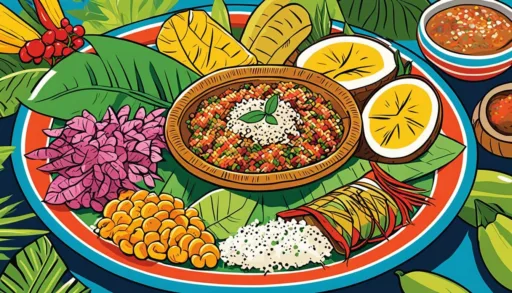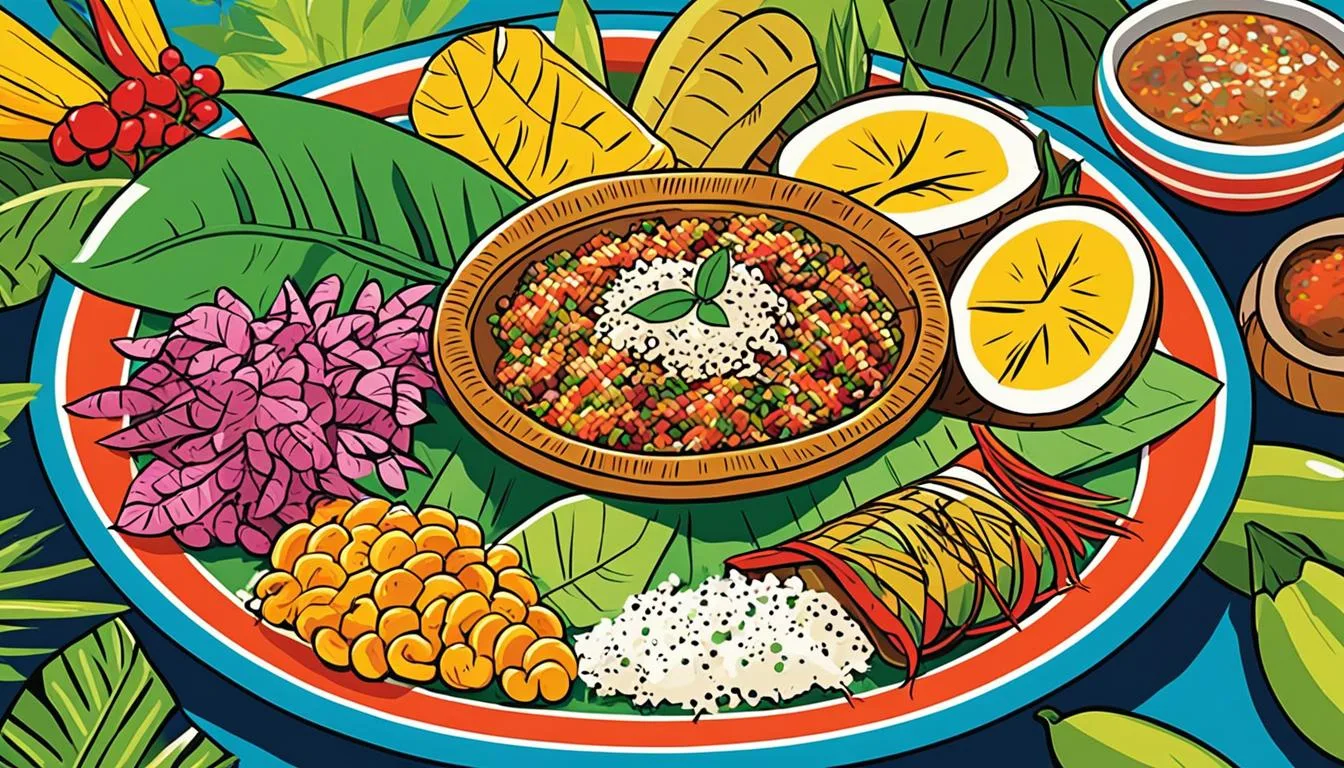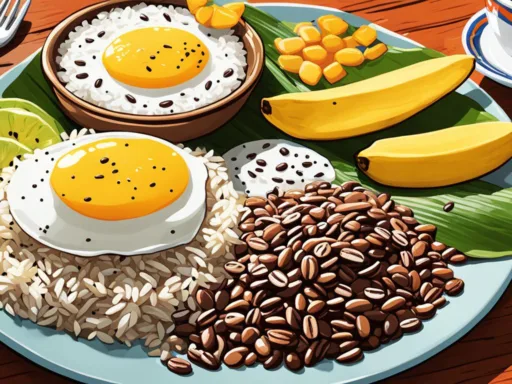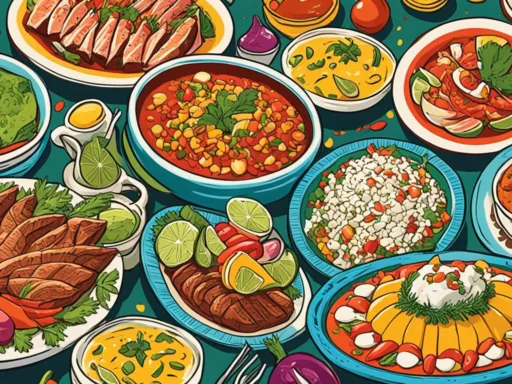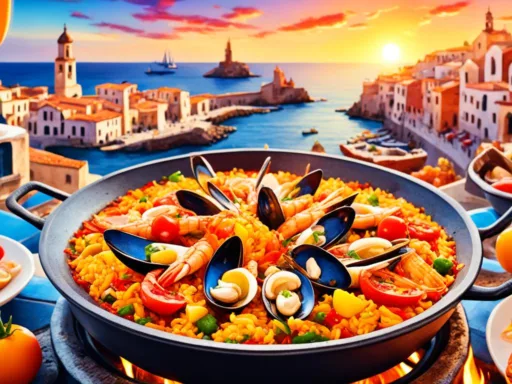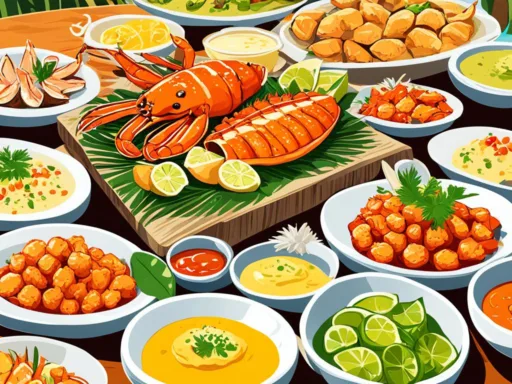Imagine embarking on a Culinary Journey like no other, where each dish tells a story woven from the verdant rainforests, the vast highlands, and the azure waters that outline its terrain. Papua New Guinea, often an enigmatic spot on the globe for many, presents Diverse Dishes and a Rich Cuisine that promises to intrigue the most curious of palates. But what delectable secrets does this Pacific gem hold? From earthy staples to fragrant feasts, every morsel holds a piece of the nation’s soul. Unlock the mystique of Papua New Guinean Culinary Discoveries – an adventure that takes you beyond the familiar and into the heart of authentic Melanesian flavors.
Key Takeaways
- Discover the unique flavors and ingredients that define Papua New Guinean cuisine.
- Learn about the traditional cooking methods, such as the Mumu, and how they bring communities together.
- Explore the significance of local produce and fresh seafood in creating a rich tapestry of taste.
- Unveil Papua New Guinea’s culinary heritage, influenced by its lush landscapes and cultural diversity.
- Get a glimpse of how modern influences are woven into traditional dishes, fostering an evolving food scene.
An Introduction to Papua New Guinea’s Cultural Tapestry
Papua New Guinea (PNG) presents a fascinating Cultural Tapestry that is rich in color, pattern, and texture. The extraordinary Ethnic Diversity of PNG is established through more than 848 tribes, each contributing its unique flavor to the country’s societal fabric. With such a mixture of communities, PNG boasts an impressive Linguistic Diversity, accounting for about 12% of the world’s languages. This diversity is also expressed through the country’s gastronomy, where each ethnic group adds to a collective repository of traditional diets and Indigenous Food Ingredients.
The Mosaic of Ethnic and Linguistic Diversity
The variety of cultures within PNG has shaped a vibrant heritage that mirrors the abundance of spoken dialects. This linguistic mosaic is not just a means of communication—it’s a testament to the Papua New Guineans’ profound connection with their land and ancestry. Every tribal language contributes to the recipes and food preparation techniques that are passed down through generations, thus enriching the Agriculture in PNG and the culinary customs.
The Crucial Role of Agriculture and Local Ingredients
In the essence of PNG’s food lies the inseparable relationship between Traditional Diets and agriculture. Taro fields, sweet potato gardens, and sago palms are more than just sources of sustenance—they represent a way of life that reveres the environment and its yields. The country’s fertility provides an assortment of organic and Indigenous Food Ingredients, central to PNG’s authentic dishes and reflective of the nation’s agricultural wealth.
Influence of Geography on Traditional Diets
The diverse geographic landscape of PNG orchestrates what the land presents to its people. From mountainous highlands to coastal plains and tropical forests, each region dictates the particular assortment of crops and aquatic life that enter the local fare. Among the Traditional Diets, coastal communities often incorporate vibrant seafood into their cuisine, which is harmonized with the staple sustenance procured through Agriculture in PNG.
| Region | Typical Ingredients | Dietary Staples | Preparation Methods |
|---|---|---|---|
| Highlands | Sweet Potato, Taro, Pork | Roasted and Steamed Dishes | Mumu Earth Oven |
| Coastal Areas | Fish, Sago, Coconuts | Grilled and Boiled Seafood | Open Fire Pits |
| Riverine Regions | Yams, Fish, Bananas | Stews and Soups | Bamboo Steam Cooking |
Undoubtedly, Papua New Guinea’s robust and vivid culture weaves a compelling narrative that beckons to be explored, particularly through its sumptuous and historically rich cuisine.
Papua New Guinean Culinary Discoveries
The gastronomic landscape of Papua New Guinea (PNG) is as rich and diverse as its cultural heritage. With a traditional diet deeply entrenched in the natural resources available, PNG’s culinary traditions offer fascinating insights into the relationship between the land, the sea, and the people who call this beautiful country home.
Exploring the Staples: From Taro to Sago
Two fundamental components of Papua New Guinean culinary discoveries are taro and sago. Taro, a starchy root crop, and sago, extracted from the pith of tropical palm trees, are both pivotal to Traditional PNG Dishes and day-to-day sustenance. Prepared in various forms, from boiled or baked to incorporated into hearty puddings and stews, these ingredients are a testament to the resourcefulness of PNG’s culinary practices.
Feasting on Festivities: Eventful Eats in PNG
During Festivities in PNG, the communal spirit of the cuisine truly shines. Celebratory dishes such as Mumu—a dish that layers meats with local vegetables and fruits, then cooks them in an earth oven—are centerpieces at community gatherings. The preparation of Mumu is a communal affair, symbolizing unity and the shared joy of feasting on significant occasions.
Aquatic Delights: Coastal and Riverine Contributions to Cuisine
Along the picturesque coastal regions and riverine areas of PNG, the bountiful seas provide a variety of seafood that enriches the Coastal Cuisine. The fresh catch of the day may include fish, shellfish, and other marine delicacies that are often grilled, baked or wrapped in banana leaves and steamed to create dishes bursting with flavor.
| Ingredient | Preparation | Celebration | Origin |
|---|---|---|---|
| Taro | Boiled, Baked, or in Puddings | Everyday Meals | Highlands |
| Sago | Stews and Sago Dumplings | Feasts and Rituals | Coastal Regions |
| Seafood | Grilled, Baked or Steamed | Festivals and Gatherings | Coastal and Riverine Areas |
| Mumu | Layered Earth Oven Cooking | Community Celebrations | All over PNG |
Unlocking the secrets of PNG’s cuisine is a voyage through time-honored traditions, rich flavors, and a dedication to the land and sea. These Papua New Guinean Culinary Discoveries highlight the country’s bountiful resources, bringing together the best of the earth and water in a seamless and delicious blend.
Traditional PNG Dishes: A Blend of Flavors and Techniques
The culinary heritage of Papua New Guinea presents an alluring palette of Traditional PNG Dishes that promise a Blend of Flavors originating from unique Cooking Techniques handed down through generations. One such iconic method is the “Mumu in a Drum,” where a variety of meats, fruits, and vegetables are layered together and slowly cooked to infuse the flavors. This traditional approach not only cooks the food but also brings communities together, celebrating the shared experience and bounty.
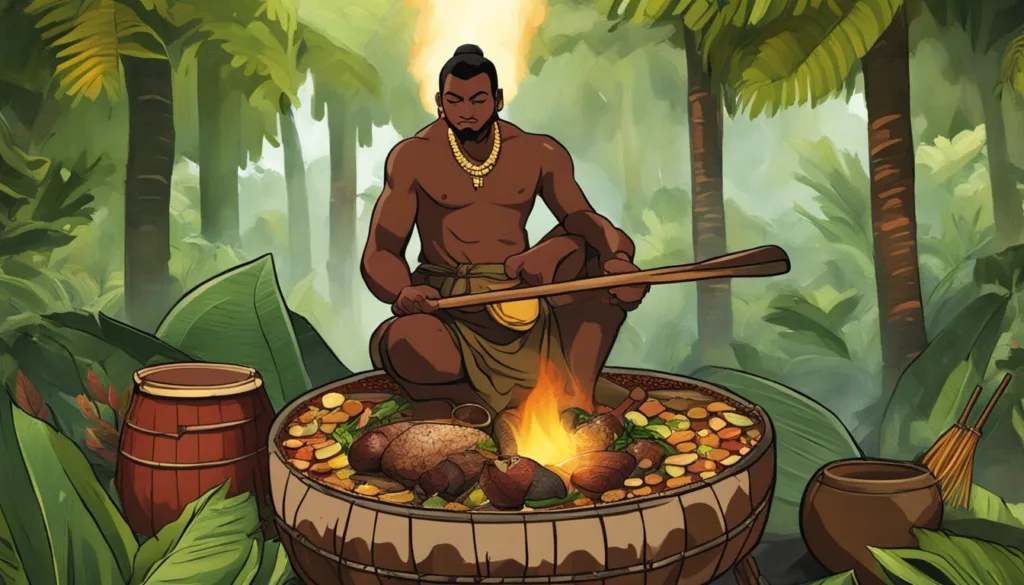
Another treasure in this gastronomic adventure are Sago Dumplings, a testament to culinary innovation with the local staple sago. These dumplings, a delightful blend of texture and taste, represent the versatility and creativity in utilizing the ingredients at hand. The rich and diverse cultures across Papua New Guinea contribute to the depth and variety of dishes that grace the dining tables, making eating in PNG a truly communal and immersive experience.
| Dish | Ingredients | Cooking Technique | Regional Origin |
|---|---|---|---|
| Mumu in a Drum | Pork, sweet potatoes, taro, bananas | Slow-cooking in an enclosed drum | Highlands |
| Sago Dumplings | Sago, coconut milk, sugar | Steaming | Coastal Regions |
The flavors that arise from mixing these traditional elements are not just a feast for the senses but also a narrative of Papua New Guinea’s cultural identity. As you indulge in these dishes, there’s a rich history to savor – each bite is a story, each taste an epoch.
Melanesian Cuisine Exploration: Indigenous Techniques and Cookware
Delving into the culinary traditions of Melanesia, particularly in Papua New Guinea, offers a fascinating gaze into the historical fabric of the region. The food preparation methods practiced for generations spotlight not only the ingenuity but also the cultural values deeply rooted within this rich tapestry.
Cooking in Earth Ovens: The Mumu Method
The earth oven, or the Mumu, is a hallmark of traditional Melanesian cooking. Earth ovens utilize indigenous techniques that harness naturally occurring elements to cook food. By wrapping ingredients in banana leaves and placing them over hot stones, the Mumu method nurtures community spirit as it requires collaboration and is often used during community feasts where everyone partakes in the meal.
The Significance of Community Feasts
Community feasts are a vibrant expression of Melanesian hospitality and societal bonds. These gatherings are not simply about sustenance but act as a platform for social exchange, story-telling, and preserving ancestral customs. The use of earth ovens in these occasions showcases a blend of culinary practice with social ceremony, solidifying relationships within the community.
Preserving Tradition: The Use of Local Utensils
Melanesian cuisine is inseparable from its traditional cookware and utensils. Handcrafted from local resources such as bamboo, coconut shell, and clay, these utensils are imbued with generations of knowledge. Using tools fashioned from the surrounding environment is a testament to sustainable practices, keeping the connection to nature alive. Resilient, practical, and often beautifully simplistic, they represent an unbroken link to a culture’s past.
Indigenous Food Ingredients: From Land to Sea
The fertile lands of Papua New Guinea are home to a medley of vibrant Indigenous Food Ingredients and Local Produce, which form the backbone of its traditional cuisine. The harmonious relationship between the people of PNG and their environment is epitomized in their diet which includes an assorted range of root crops, fruits, and leafy vegetables—each playing a significant role in the local food culture. Parallel to this terrestrial abundance is the rich offering of Seafood in PNG, where the ocean supplies endless varieties of fish and shellfish, shaping the dietary patterns along the coast.
Native Cooking Methods have been crafted to honor the natural flavors of these ingredients. Techniques such as steaming inside bamboo tubes, boiling using heated stones, and the unique grilling over open flames are reflective of the versatility and resourcefulness in PNG’s culinary practices. These methods do more than just cook food; they preserve the history and soul of the nation’s palate.
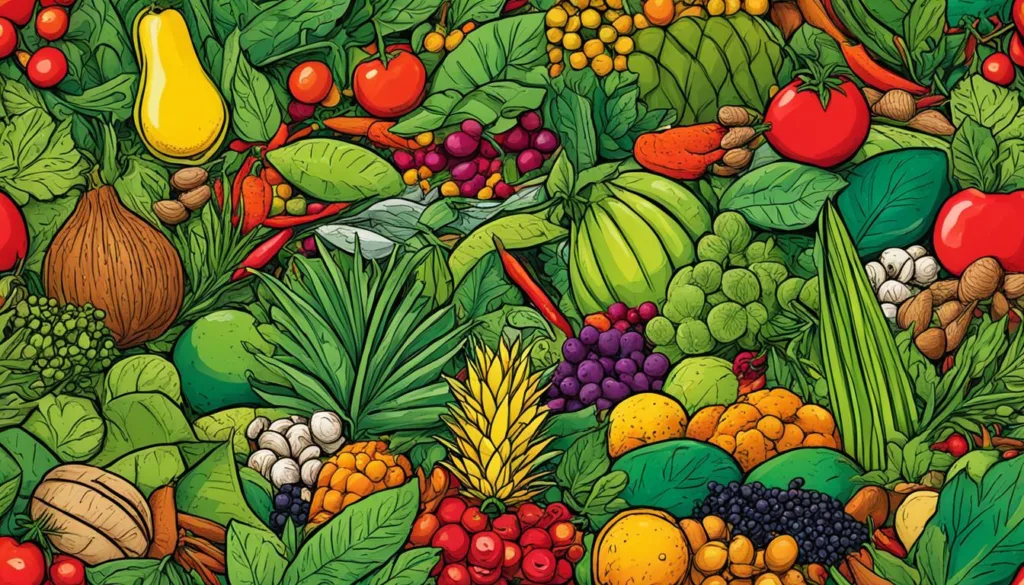
| Ingredient Category | Examples | Traditional Uses |
|---|---|---|
| Root Crops | Taro, Sweet Potato, Yam | Mumu, Boiled, Baked |
| Fruits & Vegetables | Banana, Papaya, Choko | Fruit Salads, Stews, Steam Cooked |
| Leafy Greens | Amaranth, Mustard, Ferns | Side Dishes, Stir-Fried, Wrapped Around Fish |
| Seafood | Tuna, Mackerel, Prawns | Grilled, Raw in Lime Juice, Soups |
“In every corner of Papua New Guinea’s lush landscape and its surrounding seas, there’s a flavor waiting to be discovered, a dish waiting to be savored.”
The exploration of PNG’s Indigenous Food Ingredients is not just a culinary pursuit but a voyage into the essence of the land and its people. The key is in the flavors—pure, unadulterated, and bursting with the authenticity that can only come from a place as diverse as Papua New Guinea.
Savoring the Authentic Papua New Guinea Recipes
Embark on a culinary adventure right in the comfort of your home with authentic Papua New Guinea recipes. These dishes serve as a cornerstone for family traditions and home cooking, reflecting a society rich in culture and communal values. The preparation of these delightful recipes involves skills and knowledge passed down through generations, preserving the identity of Papua New Guinea in every bite.
Home Cooking: Everyday Meals and Family Traditions
The essence of Papua New Guinean family life thrives in its authentic home-cooked meals, where the heartwarming aroma of root crops and savory delights are a regular occurrence in household kitchens. Home cooking here is not just about the food; it represents family traditions that bind the fabric of the community together.
From Garden to Kitchen: The Process of Preparing Root Crops
From the fertile gardens to rustic kitchens, the preparation of root crops is an honored practice steeped in tradition. The people of Papua New Guinea care for and harvest these staples with a sustainable ethos and a genuine respect for the land.
| Root Crop | Description | Culinary Uses |
|---|---|---|
| Taro | A starchy root, taro is revered for its nutty flavor and versatility. | Commonly used in both savory and sweet dishes, often boiled or baked. |
| Sweet Potato | A sweet and fibrous tuber, overflowing with nutrients. | Used in an array of dishes from soups to desserts, most notably in Mumu. |
| Cassava | An essential carb source which is drought-resistant and hearty. | Transformed into a range of preparations, including cassava cakes and savory pies. |
| Yam | Comes in many varieties with a denser texture and earthy taste. | Typically roasted or boiled, yams serve as a filling meal accompaniment. |
The Art of Preparing and Enjoying Betel Nut
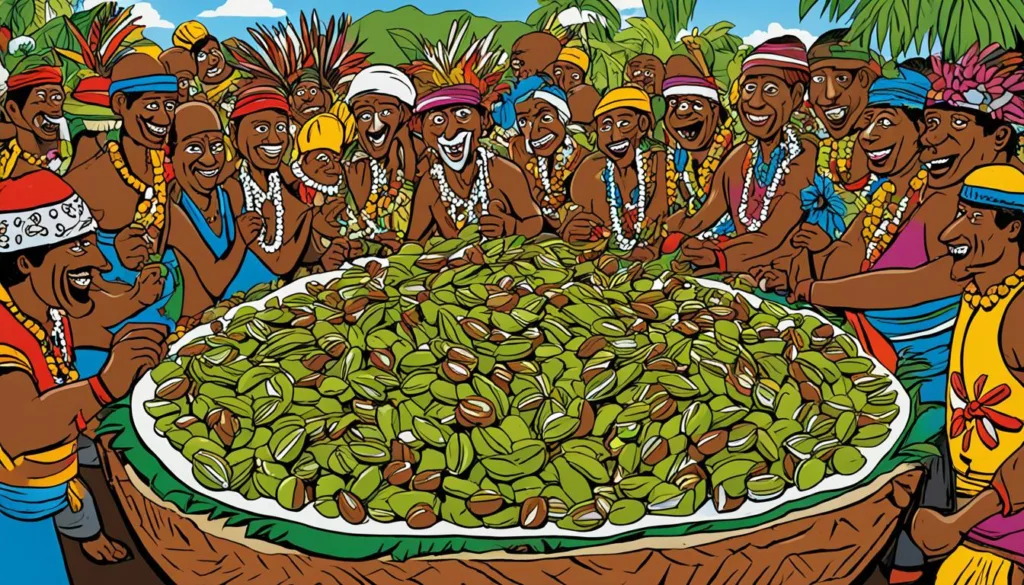
The betel nut, while not a foodstuff in the traditional sense, occupies a unique place in Papua New Guinea’s culinary panorama. Enjoyed both as a mild stimulant and a symbol of hospitality, its preparation and consumption carry ceremonial importance, defining social interactions and community bonds.
Transition of Tastes: Adapting to Modern Influences
The landscape of Papua New Guinean traditions is experiencing a remarkable culinary adaptation, where ancient practices meet modern influences. As the global appetite for diverse flavors grows, so too does the innovation in local PNG kitchens. This blend of tradition with global cuisine is not a replacement of the old ways but an expansion, adding vibrant new layers to the nation’s rich culinary heritage.
In the heart of PNG, chefs and home cooks alike are embracing culinary adaptation, using time-honored techniques to create dishes that appeal to both locals and international visitors. They fold ingredients from across the world into their recipes, crafting meals that honor the past while looking towards the future. It’s a harmonious coexistence of global cuisine and the indomitable spirit of Papua New Guinean culinary artistry.
- Integration of international spices without overshadowing local flavors
- Reimagining of classic recipes with contemporary presentation
- Collaborations between local and international chefs
- Increasing availability of global food products in local markets
- Educational exchanges through food festivals and culinary workshops
The result is a constantly evolving taste narrative, one that is being scribbled in the margins of traditional cookbooks and shouted from the rooftops of urban eateries. The role of modern influences is undeniable, yet it’s the balance with tradition that makes the culinary scene in Papua New Guinea genuinely captivating.
Culinary Creativity in Urban Centers: Port Moresby’s Food Scene
Port Moresby stands as the emblem of Culinary Creativity within Papua New Guinea, echoing the urban vibrancy through its evolving food scene. The city’s tapestry of flavors, ranging from traditional recipes to International Fusions, marks it as a destination where the gastronomic diversity is as extensive as the cultural one. Here, an exploration into its rich Urban Food Scene reveals a lineage of taste that marries heritage with transformation.
International Fusions: The Impact of Global Cuisine
In Port Moresby, global influences permeate the local fares, creating a symphony of taste where international recipes find a harmonious balance with indigenous flavors. This blending of worlds has introduced a spectrum of gourmet experiences, offering an adventurous journey for the palate and fostering International Fusions that resonate with both visitors and residents alike.
Trendy Eateries and Traditional Establishments
Amidst the city’s skyscrapers and bustling daytime commerce lie both trendy eateries and time-honored establishments. The former showcases modern dining experiences and culinary ingenuity, while the latter serves dishes steeped in tradition, connecting diners to Papua New Guinea’s ancestral roots through every bite.
Street Food and Market Discoveries: A Taste of Authenticity
Street Food in Port Moresby offers more than just convenience; it’s a foray into genuine flavors and a touchpoint of daily life for the people. Meanwhile, the city’s markets are rife with Market Discoveries, presenting a collage of local produce and artisanal delights that capture the essence of the nation’s agricultural bounty.
As Port Moresby continues to embrace change and innovation, its food scene remains a testament to the city’s spirited dynamism and the creativity that cooks in the heart of Papua New Guinea. Each dish, from a simple street snack to a sophisticated entree, is a chapter of a story told through the region’s palatable identity—an identity ever-evolving yet firmly rooted in the rich soil of its heritage.
Conclusion
In exploring the vibrant palette of tastes offered by Papua New Guinea, one dives into a culinary narrative woven from the diverse threads of the country’s food heritage. The melodic interplay between age-old traditions and contemporary influences paints a picture of a cuisine that is not static but vibrantly evolving. Embracing the food heritage of PNG is akin to partaking in a living history, rich with the flavors and knowledge of its people.
Embracing the Food Heritage of PNG
The foundation of Papua New Guinean cuisine lies in its ability to tell a story – of the land, the sea, and its community. The preservation of gastronomy goes beyond the mere replication of recipes; it involves safeguarding the narratives that each dish carries, ensuring that the cultural identity and the timeless culinary practices are passed on and not forgotten amidst the tide of change. Celebrating the food heritage is a testament to the country’s resilience and its willingness to share its cultural wealth with the rest of the world.
Preservation and Evolution of Papua New Guinean Gastronomy
As global palates become increasingly sophisticated and curious, the gastronomy of Papua New Guinea continues to evolve, introducing the world to a culinary evolution interlaced with tradition. The challenge to maintain authenticity while modernizing dishes sparks an inventive energy within the cuisine of PNG. By remaining true to the essence of their culinary roots while adapting new techniques and flavors, Papua New Guineans create a dynamic food scene poised for discovery.
The Inviting Future of PNG’s Culinary Legacy
The future of Papua New Guinea’s culinary legacy invites enthusiasts and connoisseurs alike to indulge in a journey of taste that is as rich in history as it is in flavor. The ongoing narrative of the country’s cuisine promises exciting prospects for the preservation and sharing of its gastronomic treasures. With a culinary landscape that is as versatile as it is inviting, Papua New Guinea stands ready to impart its unique legacy and enchant the gastronomic world for generations to come.
